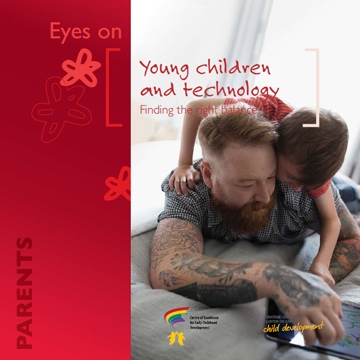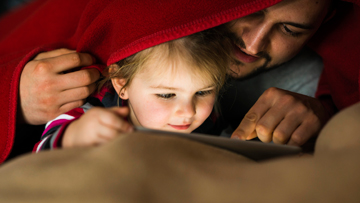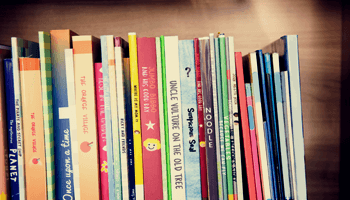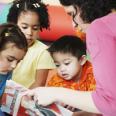Screen media are increasingly common in young children's life. It is therefore essential to understand the impact of specific technologies such as tablets or e-books for literacy and the best ways to include these technologies in children's routine at home, in childcare or in the classroom. Emerging practices and their implications for parents, teachers and policy makers are reviewed in this topic.
Synthesis PDF Complete topic PDFInformation sheets
Download the free PDF version here or purchase hardcopy prints from our online store.
Technology in early childhood education
Young children and technology: Finding the right balance

Synthesis
Topic Editor:
How important is it?
Digital media in the form of text, graphics, video and audio, usually integrated and increasingly delivered over mobile devices, are ubiquitous in homes and schools. Even the youngest children have access to these media with 83% of children aged 6 months to 6 years using screens every day for recreation, school work or reading. Here we focus on e-books and apps that are intended to support language and literacy learning by children.
Reading books with children is recognized as one of the most important contexts for language and literacy learning in early childhood. Public health and education programs have long emphasized the importance of reading to children from a young age. There is concern that e-books will supplant the traditional book before we fully understand the impact of this medium on children’s learning. One device can hold an entire library of stories. Children find digital stories to be highly engaging and many students report that they read more from screens than from paper. The digital format includes features that are entertaining but potentially distracting. Some features included in e-books are designed to make it possible for prereaders and early readers to enjoy books without adult guidance. Overall there is much concern that the time children spend with digital media replaces opportunities for high quality social interaction with adults. Understanding how children learn from digital media will support recommendations for the design, selection and use of e-books and educational apps for young children.
What do we know?
Most research on the impact of media on children’s learning has involved television and video. More recent studies have investigated children’s learning from CD-ROM, web-based, and tablet applications, including e-books, educational games, and formal instructional technology designed for school use. These studies yield some clear conclusions and directions for future research:
There is good reason to limit access to screens during the first two years of life. Infants and toddlers do not generally learn vocabulary from videos and clearly learn best from exploring their surroundings and interacting with others. Furthermore, there is some evidence that excessive “screen time” in early childhood is associated with poor attention and self-regulation.
Good quality e-books and apps will be designed to support rather than replace social interaction. Parents and teachers can support the child’s learning by participating with the child in an interactive fashion, talking about the story, asking questions, directing attention when necessary and otherwise guiding and supporting the child’s learning from the app.
Special features built into e-books are very engaging to children and have the potential to enhance the child’s attention to print. However, these engaging features are not equally helpful for learning. Multimedia features such as sound and video that is congruent with the story can deepen the child’s understanding of new words and the story. Interactive features that distract the child from the flow of the story interfere with learning.
Not all so-called “educational” apps are equally helpful for children’s learning. The app should have clear learning goals but the content should be presented in a meaningful context that actively engages the child and allows for creative exploration rather than mere rote-learning.
Some e-book features, such as text and narration in multiple languages, recording functions, pop-up dictionaries, and apps to create personalized books may be especially helpful to prepare second-language learners for school entry by strengthening the child’s knowledge of the majority language.
Teachers and parents require explicit instruction to select and use digital media effectively with young children. More research is required to identify best practices for home and classroom use of these technologies.
What can be done?
The policy response to the rapid increase in access to digital media by children has largely been directed at educating parents. Increasingly, professional associations and advisory groups are providing advice to parents (and to a lesser extent, teachers) on limits to access, the characteristics of good quality apps, and appropriate co-reading practices. Much of this advice rests on a thin research base however and draws heavily on prior research with print books or television. More research specifically designed to discover how children learn from digital media, with and without adult guidance, is required to ensure that this advice is well-founded.
Adoption of digital media in the classroom requires sufficient training and support of teachers for effective integration of technology and software into their instructional practices. Furthermore, better partnerships between researchers, teachers and software designers are required to ensure that instructional software properly reflects best practice for the teaching of literacy. For example, it is known that reading acquisition requires a particular balance of attention to phonological awareness, phonics, reading comprehension and reading fluency; however, yet apps to teach reading do not typically cover all of these components – in fact, they often fall back on a discredited “sight reading” approach to reading that is seemingly encouraged by the technology itself. A closer fit between theory, practice and design might arise from partnerships between all the stakeholders.
Finally, multiple levels of government, concerned with the “digital divide,” have devised policies to ensure that all segments of society have equal access to technologies such as desktop computers or tablets. These policies have been quite successful in that access to hardware is relatively well distributed in western society. However research shows that socioeconomic gaps are currently greater in terms of the way that different families use digital technologies. Public health agencies, librarians and educators have a role to play in ensuring that children and parents in all families know how to access and use these technologies to their best advantage, ensuring greater equality in both literacy and digital literacy.
Discover more

Can e-books and educational apps help children learn language and literacy?
Reading books with children is recognized as one of the most important contexts for language and literacy learning in early childhood. Literacy learning has been transformed by digital media that comes in the form of text, graphics, audio and video integrated into entertaining apps that can be delivered to children anywhere on mobile devices. Popular advice to parents is conflicting, ranging from enthusiastic support of educational apps to dire warnings of potential harm. What does the research say about e-books and learning apps for young children?
First, there is no evidence that babies and toddlers learn language from video and it is wise to limit “screen time” during the first two years.
For preschool age children, e-books and educational apps can be beneficial especially when an adult guides the child’s learning. Parents can read e-books with their child, commenting on the child’s actions and on the story, asking questions, and directing their child’s attention to important aspects of the text and illustrations.
Not all “educational” apps are beneficial. The best apps integrate multimedia features in a way that is congruent with story or learning goal to support learning. Too many bells and whistles in an app can be distracting and interfere with learning. A good quality app will present content in a meaningful context that actively engages the child and allows for creative exploration rather than mere rote-learning.
Many resources to support the selection and use of apps at home and school are now available on the web.
Publications
Literacy Technologies and the Early Years of School
Electronic(E)-books as a Support for Young Children's Language and Early Literacy
Infants, Toddlers and Learning from Screen Media
Learning in the Digital Age: Putting Education Back in Educational Apps for Young Children

Resources and bulletins
The Encyclopedia also recommends...
How e-books support children's language | Dr. Susan Rvachew
Mat Time Series by Storypark
Digital books for early years and primary school aged children
MESH Guides (also available in French & other languages)
Screen time and preschool children
Position statement | Canadian Paediatric Society (CPS), 2023
Screen use in school-aged children and adolescents
Position statement | Canadian Paediatric Society (CPS), 2019
Clinical tools and resources | Canadian Paediatric Society (CPS)
Screen time and young children
Information for parents | Canadian Paediatric Society (CPS)





